This set of Class 12 Physics Chapter 1 Multiple Choice Questions & Answers (MCQs) focuses on “Electric Field Lines”.
1. The electric field lines diverge from _______
a) Positive charge
b) Negative charge
c) Dipole
d) Zero potential point
View Answer
Explanation: Electric field lines always converge at a negative charge and diverge from the positive charge. If a unit positive charge is kept in an electric field, the path of motion of that charge is known as field lines. Now we know that a positive charge is always pushed away by another positive charge. Thus we can find the direction of field lines near a positive charge.
2. Two electric field lines ______
a) Always intersect each other
b) Never intersect
c) May intersect sometimes
d) Are always perpendicular to each other
View Answer
Explanation: We know that the electric field at a point is directed towards the tangent of electric field lines at that point. Now if two field lines intersect at a point, two tangents can be drawn at that point. That means at a particular point there would be two separate directions of the electric field which is impossible. So, we can conclude that two electric field lines never intersect each other.
3. Consider the lines of force as shown in the figure. Two unit positive charges are kept at points A and B.
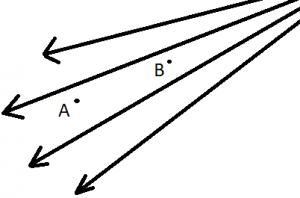
a) Charge at A will suffer greater force
b) Charge at B will suffer greater force
c) Force at both points will be same but non-zero
d) Force at both points will be the same
View Answer
Explanation: More number of field lines cross unit cross-section area at point B. Therefore electric field intensity will be more at point B than that of point A. Thus a unit positive charge will face greater force at point B than point A. So we can conclude that field intensity will be greater where the field lines are dense.
4. Field lines due to a positive point charge are _______
a)
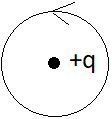
b)
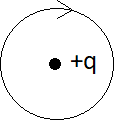
c)
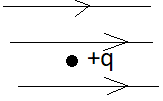
d)
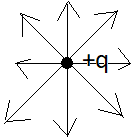
View Answer
Explanation: We know that field lines are created from a positive charge and they repel each other and always try to maintain maximum distance among them. Therefore they propagate from a positive point charge in radially outward and radially inward in case of a negative point charge. Field lines are circular in the case of a current carrying conductor.
5. Two plates are oppositely charged uniformly and kept parallel to each other at a certain distance. What will be the nature of electric field lines in between them?
a) Circular
b) Parallel to each other throughout the cross section
c) Not uniformly distributed
d) Parallel and uniform in central part but fringes out at the extreme ends
View Answer
Explanation: The electric field between two uniformly charged plates is uniform. Electric field lines in the uniform electric field are parallel to each other and uniformly distributed. This phenomenon is observed in most of the parts between the plates. But in the two extreme ends, the field line fringes out due to the non-uniform electric field.
6. It is observed that N number of field lines come out perpendicularly from the unit surface area of the sphere. What is the amount of charge inside the sphere? ∈ is the dielectric constant of the medium.
a) -4πR2 N∈
b) 4πR2 N∈
c) \(\frac {4\pi R^2}{N\epsilon}\)
d) –\(\frac {4\pi R^2N}{\epsilon}\)
View Answer
Explanation: Field lines come out from the surface. That means the charge must be positive. According to Maxwell’s principle, field lines coming out from a charge q is equal to \(\frac {q}{\epsilon}\) where ∈ is the relative permittivity. The total number of field lines coming out of the sphere is 4πR2N. This must be equal to \(\frac {q}{\epsilon}\). Therefore q=\(\frac {4\pi R^2}{N\epsilon}\).
7. A field line can diverge from and converge at the same conductor. The statement is _____
a) True
b) False
View Answer
Explanation: For the phenomenon to happen in practice, both positive charge and negative charge must be present on the same conductor. But as a conductor carries electricity and can never store charge at a localized part, this phenomenon can never occur. Field lines are circular for a current carrying conductor and their direction depends on the direction of the flow of current.
8. Which among the following is false about electric field lines?
a) They are continuous
b) They attract each other
c) They remain parallel in a uniform electric field
d) They diverge from positive charge
View Answer
Explanation: Electric lines of force are always diverging from positive charge and they converge at a negative charge. Besides, they repel each other because of repulsion between two similar charges. They remain parallel to each other in the uniform field but may divert in case of a non-uniform field. These lines are continuously stretched between two opposite charges and always try to maintain minimum length.
9. At ‘Electrical Neutral Point’ the lines of force _______
a) Are absent
b) Coincide with each other
c) Always converge
d) Always diverge
View Answer
Explanation: Electrical neutral point is a point in between two positive and negative charges, where the electric field intensity is zero. It means that no lines of force pass through that point because electric field lines are the measure of field intensity i.e. more lines mean more field intensity. The lines never converge or diverge neither they coincide at that point.
10. Two unit positive charges are kept at coordinates (0, 0) and (10, 0). What will be the variation of the electric field with respect to the distance between them?
a)
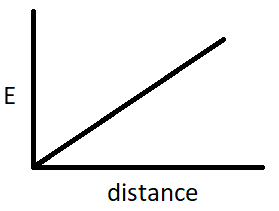
b)
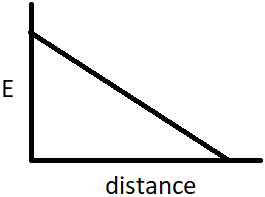
c)
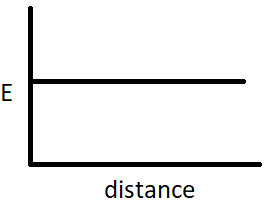
d)
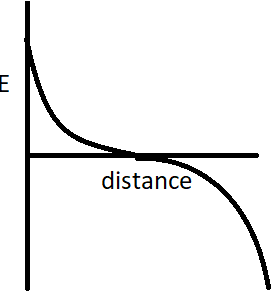
View Answer
Explanation: Electric field intensity at the midpoint between the two charges must be zero as both of the charges are positive. We also know that field intensity varies inversely with the square of the distance. When we pass through the midpoint, we find that the direction of field changes from positive to negative. The field doesn’t remain constant or keep on increasing or decreasing uniformly.
11. 1 dyne/esu = _____ N/C
a) 3*104
b) 105
c) 3*105
d) 9*104
View Answer
Explanation: 1 N/C = \(\frac {1 N}{1 C} = \frac {10^5 dyne}{3*10^9 esu} = \frac {1}{3*10^4}\)dyne/esu. Therefore 1 dyne/esu=3*104 N/C. Both of them are the unit of electric field intensity. But N/C is the unit of electric field intensity in the SI system while dyne/esu is the unit of field intensity in the CGS system.
12. What can be the nature of charges q1 and q2?
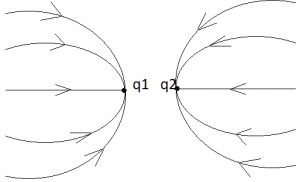
a) q1 is positive, q2 is negative
b) q1 is negative, q2 is negative
c) q1 is negative, q2 is positive
d) q1 is positive, q2 is positive
View Answer
Explanation: From the properties of field lines, we know that field lines head towards a negative charge and go away from positive charge. Therefore from the diagram it is clear that both the charges q1 and q2 are negative as field lines are heading towards both the charges. The midpoint between these two charges will be electric neutral point where there will be no field lines.
Sanfoundry Global Education & Learning Series – Physics – Class 12.
To practice all chapters and topics of class 12 Physics, here is complete set of 1000+ Multiple Choice Questions and Answers.
If you find a mistake in question / option / answer, kindly take a screenshot and email to [email protected]
- Practice Class 12 - Chemistry MCQs
- Practice Class 11 - Physics MCQs
- Check Class 12 - Physics Books
- Practice Class 12 - Biology MCQs
- Practice Class 12 - Mathematics MCQs
